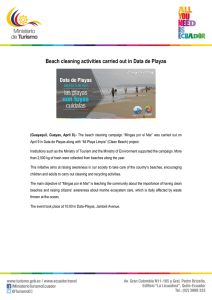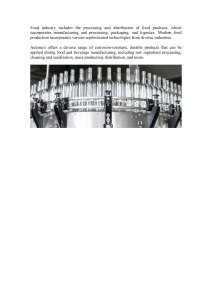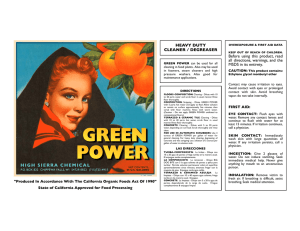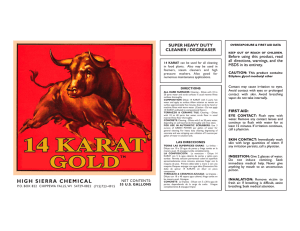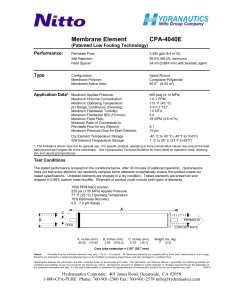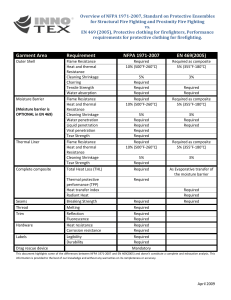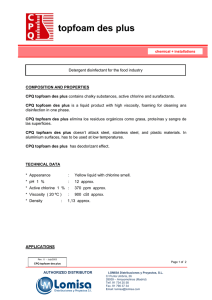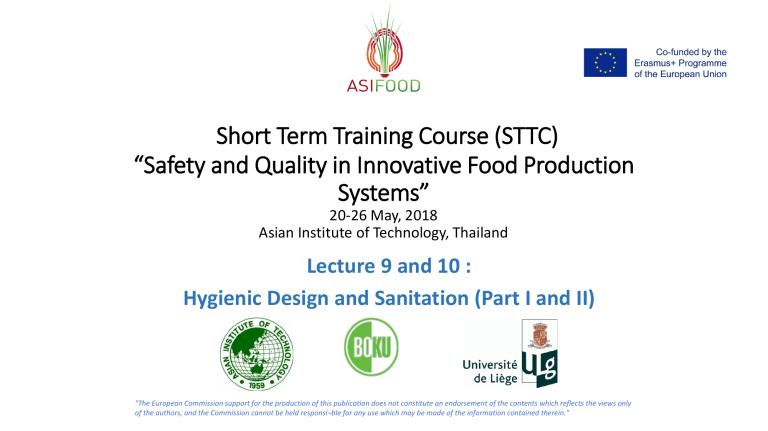
Short Term Training Course (STTC) “Safety and Quality in Innovative Food Production Systems” 20-26 May, 2018 Asian Institute of Technology, Thailand Lecture 9 and 10 : Hygienic Design and Sanitation (Part I and II) "The European Commission support for the production of this publication does not constitute an endorsement of the contents which reflects the views only of the authors, and the Commission cannot be held responsi¬ble for any use which may be made of the information contained therein." Hygienic Design and Sanititation Gerhard Schleining 1 HYGIENIC DESIGN 22.05.18 contents • role of hygienic design within food safety • standards – guidelines • scope of hygienic design • aspects of building design • aspects of equipment design, installation und integration • sanitation 2 HYGIENIC DESIGN 22.05.18 FOOD SAFETY is a matter of the whole food supply chain Influence of secondary processes like cleaning, chilling on the: Acceptable microbial count ProduktProduct Planung Design Agrarische Primary Production Primärproduktion Industrielle Industrial Production Produktion Produkt Product Transport Logistik Logistics Handel Trade Verkauf Lagerung Storage Houeshold Haushalt Konsum Use Consumtion Nutzung Entsorgung Disposal chilling FOOD SUPPLY CHAIN cleaning, disinfection • • • biological chemical hazards physical by § HUMAN § ENVIRONMENT § EQUIPMENT P raw materials heat treatment Production 22.05.18 HYGIENIC DESIGN 3 22.05.18 HYGIENIC DESIGN Transport Logistics Consumption 4 HAZARDS Quality Biological HYGIENE Ø parasites, vermints, pests, rodents Ø microorganism Ø Natural biological toxins (Mycotoxins) preventive measures Product Hygiene: Chemical Ø Control of raw materials (supplier audits, acceptance tests) Ø Control of intermediate and end products (shelf life) Residues of: Ø pestizides, herbizides, fungizides, fertilizers, pharmaceuticals Ø Processing contaminants (nitrosamins, fat oxidation, migration) Ø Environmental contaminants: food allergens, heavy metals Ø lubricants, cleaning agents and desinfectants, paintings Process Hygiene: Ø requirements to building and equipment Ø cleaning, desinfection, pest control Ø Compliance of temperature-time-relations, storage conditions and product flow (cross contamination!!) Ø waste management Physical Foreign bodies: Ø foreign food materials: last batch, seeds Ø glass, wood, stones, hairs, debris (product) Ø splitter of paintings, rust Ø dust, paper Personal Hygiene: § GMP § HACCP § .... § HYGIENIC DESIGN § .... § preventive maintenance Ø dress code, behaviour, if necessary adaption of sanitary rooms Ø training !!! 5 HYGIENIC DESIGN 22.05.18 Hygiene is the essential basis for the quality of a food product PRODUCT QUALITY depends also on the design and quality of the used equipment 22.05.18 DIN EN ISO 14159 DIN EN 1672-2 6 HYGIENIC DESIGN EQUIPMENT MANUFACTURER Machinery Directive 2006/42/EC design equipment EQUIPMENT MANUFACTURER equipment design installation FOOD MANUFACTURER process product design HYGIENE GMP/HACCP/... cleanability functionality safety OPERATIONAL SAFETY capability processing EQUIPMENT QUALITY POTENTIAL CONFLICT “hygiene package” cleaning design and control process FOOD MANUFACTURER (equipment user) directive 95/63/EEC safety and health requirements for the use of equipment by workers PRODUCT QUALITY 22.05.18 HYGIENIC DESIGN 7 22.05.18 HYGIENIC DESIGN 8 REGULATIONS degree of details § § Regulation 852/2004: The layout, design, construction and size of food premises are to permit adequate maintenance, cleaning and/or disinfection, avoid or minimise air-borne contamination, and provide adequate working space to allow for the hygienic performance of all operations……. 2006/42/EC : Machinery Directive STANDARDS § § DIN EN ISO 14159: Safety of machinery – Hygiene requirements for the design of machinery DIN EN 1672-2: Food processing machinery – Basic concepts – Hygienic Requirements EHEDG-GUIDELINES general design criteria, materials of construction closed equipment for liquid products open equipment (conveyor belts, mixer, etc.) technics: welding, passivation of stainless steel aspects: air, water, lubricants equipment: pumps, valves, pipes, couplings, sealings is a consortium of equipment § processes: thermal treatment (pasteurisation, manufacturers, food industries, research sterilisation, chilling), dry products, packaging institutes and public health authorities, (materials), cleaning § § § § § § founded in 1989 with the aim to promote hygiene during the processing and packing of food products (http://www.ehedg.org/) GUIDELINES EHEDG-TEST-METHODS Interpretation must always be done in relation to the local situation: § § § § § specific product requirements specific process requirements available equipment available staff environment HYGIENIC DESIGN 22.05.18 Procedures for evaluation, test and certification of equipment for authorisized test laboratories § in-place cleanability, in-line pasteurisation, in-line steam sterilisability § Bacteria tightness of equipment § Bacteria impermeability of membran filters 9 certified eqipment is listed at: http://www.ehedg.org/certequip.htm check lists to evaluate equipment 3A-STANDARDS independent, not-for-profit corporation dedicated to advancing hygienic equipment design for the food, beverage, and pharmaceutical industries (founded 1920 ) http://www.3-a.org • • • • • • • • • 01-08 Storage Tanks 11/2001 02-10 Centrifugal and Positive Rotary Pumps 1/2006 04-04 Homogenizers and Reciprocating Pumps 11/1996 10-04 Filters Using Single Service Filter Media 11/2000 11-08 Plate-Type Heat Exchangers 1/2007 12-07 Tubular Heat Exchangers 11/2003 13-10 Farm Milk Cooling and Holding Tanks 11/2003 16-05 Product Evaporators and Vacuum Pans 8/1997 …… • Grocery Manufacturers Association (GMA, http://www.gmabrands.com/) • American Meat Institute (AMI, http://www.meatami.com/) based on design principles 3A- ACCEPTED PRACTICES • 603-07 Sanitary Construction, Installation, Testing, and Operation of High-Temperature Short-Time and Higher-Heat Shorter-Time Pasteurizer Systems 11/2005 • 604-05 Supplying Air Under Pressure for Contact with Product or Product Contact Surfaces 11/2004 • 605-04 Permanently Installed Product and Solution Pipelines and Cleaning Systems 8/1994 • 606-05 Design, Fabrication, and Installation of Milking and Milk Handling Equipment 11/2002 • ……… 22.05.18 HYGIENIC DESIGN 11 22.05.18 HYGIENIC DESIGN 12 SUMMARY SUMMARY • food safety is a matter of the whole food supply chain • hazards arise from human and environment and also from equipment • operational safety requirements conflict with hygienic requirements in many cases • secondary processes like cleaning effect the shelflife of products, if buildings and equipment is of poor design - cleaning will be difficult and time consumable • interpretation of regulations and standards must always be done in relation to the local situation (specific product and process requirements, available equipment and staff, environment) • hygiene is the essential basis for the quality of a food product • product quality depends also on the design and quality of the used equipment HYGIENIC DESIGN 22.05.18 • guidelines (knowledge, experiences and sometimes simple solutions) are available 13 HYGIENIC DESIGN 22.05.18 ASPECTS OF HYGIENIC DESIGN 14 HYGIENIC DESIGN • BUILDING DESIGN Plant Enclosure Related Aspects Lay-Out Related Aspects Air Related Aspects Water Related Aspects Zoning § EQUIPMENT DESIGN § EQUIPMENT INSTALLATION AND INTEGRATION Source: K. Lorenzen, GEA Tuchenhagen 22.05.18 HYGIENIC DESIGN 15 22.05.18 HYGIENIC DESIGN 16 HYGIENIC DESIGN STRATEGIES BUILDING DESIGN PLANT ENCLOSURE RELATED ASPECTS • avoid infestation by insects, birds, animals • avoid contamination with foreign organisms and foreign materials • avoid conditions which enhance the growth of micro-organism (accumulation of dust, surface/condensed water, product) • improve cleanability 22.05.18 BUILDING DESIGN HYGIENIC DESIGN 17 LAY-OUT RELATED ASPECTS § Placement of rooms (Zoning): separate dry and wet areas, short product routing without crossings § Interior building element surfaces should be non-electrostatic, smooth, round corners and have good accessibility for cleaning § No metal panels high heat transfer -> condesation -> expansion -> sealings 22.05.18 HYGIENIC DESIGN 19 22.05.18 BUILDING DESIGN HYGIENIC DESIGN 18 LAY-OUT RELATED ASPECTS § Materials should be resistant to food components, cleaning agents and disinfectants No wood and standard glass in open processing areas, but polymer material like polycarbonate or strengthened glass (standard glass with protective film) STAINLESS STEEL 22.05.18 HYGIENIC DESIGN 20 BUILDING DESIGN BUILDING DESIGN MATERIALS LAY-OUT RELATED ASPECTS PLASTICS Drainage § not in dry areas ELASTOMERS § as far away as possible from processing equipment § sufficient sloping § ability to close during production § water lock must be intact 22.05.18 BUILDING DESIGN HYGIENIC DESIGN 21 LAY-OUT RELATED ASPECTS 22.05.18 BUILDING DESIGN HYGIENIC DESIGN 22 LAY-OUT RELATED ASPECTS § Framework: open profiles, mounted with tight fit, no hollow bodies and horizontal surfaces, enclosed in concrete Drainage Sloped floor to prevent water collection (upfront cost): $1.2M If not sloped, 22 employees x 1.25 h/day x 220 days required to drain the floor = 6 050 h/year § Platforms and walkways: should be minimised, not above open processes 6 050 h/year x $30/h = $181 500/year to draw water to a drain Payback Period of $1.2M divided by $181 500/year = 6.61 years A properly sloped floor would have lasted much longer than this, with savings of $181 500 on manufacturing costs every year thereafter! 22.05.18 HYGIENIC DESIGN 23 22.05.18 HYGIENIC DESIGN 24 BUILDING DESIGN § LAY-OUT RELATED ASPECTS LAY-OUT RELATED ASPECTS § Doors: without any hollow body and seals (should be monitored regularly) ambient pressure difference should be preferred avoid false/dropped ceiling constructions (control rooms) a) b) c) § Windows: not be able to open or insect screens (easily accessible, cleanable or replaceable), § no or 45° sloped sills and ledges 22.05.18 BUILDING DESIGN 25 HYGIENIC DESIGN PIPING BUILDING DESIGN • Insulations against noise or condensation: avoid as much as possible, no perforated or electrostatic materials, water tight and removable for inspection and cleaning better: “hot/cold room concept” 22.05.18 26 HYGIENIC DESIGN PIPING BUILDING DESIGN § in separate and accessible gangways and enter the process area through the ceiling § open trays without horizontal ledges, crevices or gaps § never be installed behind double ceilings and above open production lines § as short as possible § avoid “dead spaces”: couplings, seals, valves, sensors !!!!! 22.05.18 HYGIENIC DESIGN 27 22.05.18 HYGIENIC DESIGN 28 RISK because of bad welding RISK because of bad welding cleaning and desinfectants effect the biofilm only at the outer part Particles from corrosion are rinsed from the crevice only a small part of the biofilm is removed with the cleaning agent The inner part of the biofilm is not effected 22.05.18 29 HYGIENIC DESIGN growths of microorganism 30 HYGIENIC DESIGN 22.05.18 CABLE MOUNTING BUILDING DESIGN avoid dust and condensations microorganism duplicate at optimum conditions every 20 min hygiene risk Listeria monocytogenes: 0.5 °C - 50 °C pH 4.5 - 9.6 NaCl: up to 12 % aw min 0.92 correct hollow body full tray acoustic insulation electric wires open ends horizontal grid funnel grid or sheet, one-layer, sloped or vertical 22.05.18 HYGIENIC DESIGN hours 31 22.05.18 HYGIENIC DESIGN 32 CABLE MOUNTING BUILDING DESIGN LIGHTING BUILDING DESIGN § not close to doors (insects) § not above open processes (foreign bodies) avoid contamination avoid dust and condensations hygiene risk correct horizontal surfaces water tight integrated soil slope HYGIENIC DESIGN 22.05.18 BUILDING DESIGN 33 AIR RELATED ASPECTS 22.05.18 BUILDING DESIGN polycarbonate instead of glass HYGIENIC DESIGN 34 WATER RELATED ASPECTS avoid contamination with dust particles and flow from higher care to low care hygiene areas micro-organisms environmental air § § § from low to higher dust loaded areas USDA: minimum air change: 6/h, 20-30/h when high load of dust or moisture light overpressure (~ >10%) with filterd air (~50 µ) dust extraction process and transport air § inlet at a single location, > 3m above the ground level, >10m away from any exhaust discharge point instrument air § 22.05.18 outlet away from open and dry products HYGIENIC DESIGN 35 22.05.18 HYGIENIC DESIGN 36 BUILDING DESIGN WATER RELATED ASPECTS BUILDING DESIGN WATER RELATED ASPECTS specify, separate and monitor different water qualities Water quality control § § § process/product water utility water potable water § § specifications no connections Legionella spp. (EHEDG Doc. 24 2004) § § 22.05.18 HYGIENIC DESIGN 37 22.05.18 ZONING right design and placing of equipment like cooling towers, evaporative condensers, domestic water systems, pressure jetting systems, can/bottle washing systems, emergency showers; fire sprinklers, fountains, garden hoses and sprinklers, spray humidifiers and air washers, machine tool cooling units, conveyor lubrication, … avoid stagnant water (drainage), formation of aerosols HYGIENIC DESIGN 38 ZONING § means keeping out and keeping away of unwanted items § specify areas and barriers § requires knowledge about products and processes (what must be prevented) § must be logically and practically for all persons concerned § must be economically § rules must be followed by all -> Training is essential Do not forget: § cleaning utensils § spare parts § drainage § fire protection § waste collection § air conditioning ….. glove box to prevent emission of unwanted contaminants (www.plas-labs.com) 22.05.18 HYGIENIC DESIGN 39 22.05.18 HYGIENIC DESIGN 40 example ZONING ZONING CLASSIFICATION cleaning requirements § according hygienic requirements: B (basic) no or closed production M hygienic requirements wet H (medium) (high) temporary open production open production § and according cleaning requirements: w (wet) cw (controlled wet) Bw d 22.05.18 HYGIENIC DESIGN 41 example ZONING Bcw dry Bd courtyard, car park office, store house dry store Mw Mcw Md bottle washing closed filling milling Hw Hcw Hd (dry) open filling With different rules for installation, personnel behaviour, cleaning, etc. controlled wet open filling powder filling 42 HYGIENIC DESIGN 22.05.18 BARRIERS ZONING § Zones should be clear visible (by barriers for staff and products) § walls, lines on the ground, drains (water lock!!), air filters, transfer windows § access points for products, personnel, air, utilities traffic conditions drains, seals § § § are critical and must be systematically monitored !!!!! Elevators can not be barriers !! non-accessible spaces, air drafts If different hiegenic zones are accessable by stairs or elevators air locks must be installed high care areas: barriers should be installed as close as possible to the product, e.g. integrated HEPA-Filter (pill press) 22.05.18 HYGIENIC DESIGN 43 22.05.18 HYGIENIC DESIGN 44 EQUIPMENT DESIGN EQUIPMENT DESIGN product contact surfaces Surfaces which are exposed intentionally or unintentionally to the product and surfaces from which splashed product, condensate, liquids or material may drain, drop, diffuse or be drawn into the product or onto product contact surfaces or surfaces that come into contact with product contact surfaces of packaging materials. NOTE: Product contact surfaces may contribute to crosscontamination, and must therefore be included in the hazard analysis. 48 HYGIENIC DESIGN 22.05.18 product contact surfaces must comply with the regulations set by the European Union and the United States (FDA). Food contact surfaces must be: • non-reactive with the product, cleaning agents (migration, absorption) • non-contaminating of the product • noncorrosive • non-toxic • non-absorbent of any kind of liquid • mechanically stable • cleanable to ensure prevention of biofilm formation and harborage niches for microorganisms, allergen-containing residues or other chemical contaminants. Surfaces must be finished to a degree of surface roughness that is smooth enough to enable them to be easily cleaned and disinfected. The surface finish must be such that there are no cracks, pits or cavities where water or soil might remain which would give rise to potential contamination. the surface finish (roughness Ra £ 0.8 µm) must not be affected under conditions of use (cold rolled steel has 0.2 £ Ra £ 0.5 µm and does not need to be polished) 22.05.18 EQUIPMENT DESIGN HYGIENIC DESIGN 49 EQUIPMENT DESIGN penetration depth in micro gaps surface finish Ra = 0.4µm Ra = 0.9µm electropolished bead-blasted 22.05.18 HYGIENIC DESIGN 50 22.05.18 HYGIENIC DESIGN 51 EQUIPMENT DESIGN EQUIPMENT DESIGN avoid accumulation of water / product avoid accumulation of dust / water(condensate) / product § self draining without dismantling hygiene risk § no horizontal surfaces § no ledges correct § no hollow bodies § no dead spaces .... hygiene risk correct dead space 22.05.18 52 HYGIENIC DESIGN HYGIENIC DESIGN 22.05.18 53 EQUIPMENT DESIGN effect of flowrate on dead ends avoid accumulation of dust / water / product • avoid dead end VTS_25_1 VTS_06_1 • avoid crevices VTS_01_1 VTS_04_1 22.05.18 HYGIENIC DESIGN 54 22.05.18 HYGIENIC DESIGN 55 EQUIPMENT DESIGN CONVEYOR BELTS • avoid crevices EHEDG Doc 13 • All surfaces should be accessable for cleaning • Avoid cross contamination • 22.05.18 HYGIENIC DESIGN 56 castors reinforcement 22.05.18 HYGIENIC DESIGN Covered edge 57 EQUIPMENT DESIGN, -INSTALLATION, -INTEGRATION § avoid misalignment § no corners min ≥ 3mm 22.05.18 HYGIENIC DESIGN 58 22.05.18 HYGIENIC DESIGN 59 EQUIPMENT INSTALLATION/INTEGRATION EQUIPMENT INSTALLATION/INTEGRATION avoid accumulation of dust / water(condensate) / product avoid accumulation of dust / water(condensate) / product § support structures must be sealed to floor/wall/ceiling without any pockets or gaps 60 HYGIENIC DESIGN 22.05.18 § accessability: > 0.3m above the floor and from walls, depending on size of cleaning tools 22.05.18 INSTALLATION OF SENSORS § avoid dead space hygiene risk correct dead space flow against sensor HYGIENIC DESIGN 61 INSTALLATION, INTEGRATION • sensor not cleanable • measured value not relevant 22.05.18 HYGIENIC DESIGN 62 22.05.18 HYGIENIC DESIGN 63 INSTALLATION, INTEGRATION INSTRUMENTATION hygiene risk correct Source: Lelieveld H.L.M. et.al.: Hygiene in Food Processing Woodhead publishing Limited 64 HYGIENIC DESIGN 22.05.18 correct • if buildings and equipment is of poor design - cleaning will be difficult and time consumable • operational requirements conflict with hygienic requirements in many cases • knowledge, experiences and sometimes simple solutions are available, but need to be transferred to equipment manufacturers and to food producers § main issues of hygienic design are to: § avoid contamination by foreign organisms and materials § avoid conditions which enhance the growth of micro-organism § improve cleanability § risks by poor hygienic design are caused by : § § § § § § 22.05.18 HYGIENIC DESIGN 65 SUMMARY INSTRUMENTATION hygiene risk HYGIENIC DESIGN 22.05.18 66 22.05.18 wrong placement of equipment and utility installations horizontal surfaces, hollow bodies dead spaces, bad drainage insufficient cleanability/accessability use of non-resistant materials, etc. The concept of zoning is well known in the pharmaceutical industry and should be used more frequently in the food industry HYGIENIC DESIGN 67 69 SUMMARY • • • • • • Sanitation product contact surfaces must be inert to product and cleaning agents, surface finish (roughness Ra £ 0.8 µm) must not be affected under conditions of use equipment should be selfdraining no horizontal surfaces, hollow bodies, crevices, dead spaces to avoid accumulation of dust / water(condensate) / product corners should have a radius ≥ 6mm support structures must be sealed accessability > 0.3m • • • • • definitions cleaning microbial destruction cleaning methods sampling special care must be taken to: • insulation • installation of sensors (dead space) • instrumentation 22.05.18 HYGIENIC DESIGN SOME DEFINITIONS “Cleaning”: Removal of soil (food residues, dirt, grease or any other objectionable matter in an incorrect location) “clean”: free of visible soil “Disinfection”: Reduction of the number of microorganisms to an acceptable level by chemical agents and/or physical methods “Disinfectant”: chemical agent that is used after cleaning for killing a certain proportion/type of micro-organisms remaining on the surface HYGIENIC DESIGN 68 HYGIENIC DESIGN CLEANING WHAT IS SOIL? • Food and non-food material (dirt, dust, organic material, allergens!) in an incorrect location, like fat deposit on a cutting board, lubricant on a conveyor belt, …. • water soluble – no problem: inorganic salts, sugar (caramelised), starches, minerals, … • soluble in acidic solutions (inorganic materials): calcium carbonate, metal (Fe, Zn) oxids, waterand milkstone (precipitated by heat) • soluble in alcaline solutions (organic materials): fats (polymerised), proteins (polymerised, denatured) HYGIENIC DESIGN Gerhard Schleining 22.05.18 BIOFILMS WHAT IS FOULING? Fouling is the undesired deposition of material on surfaces • layer of microcolonies of bacteria associated with an inert surface attached by a matrix of complex polysaccharid-like material (glue) in which other debris including nutrients and other microorganisms (also viruses) may be trapped • Inorganic fouling („Scaling“: precipitation of inorganic crystals) • first stage: electrostatic attraction (reversible) second stage: exudation of extracellular polysaccharids • Organic fouling (deposition of fat, oil, protein etc.) • unique environment established resistent to sanitizing agents (-1000x), heat more effective than chemical (watersoluble) sanitizers, teflon easier to clean than stainless steel • Biofouling (deposition and growth of microorganisms on surfaces) – particles which can multiply on the expense of nutrients • new microorganisms attach themselfes with the aid of filaments and tendrils • can behave like a tough plastic • for cleaning the most important task is the detachment from the surface to be cleaned In non-sterile systems, biofilms cannot be avoided HYGIENIC DESIGN 22.05.18 Emergent properties in biofilms: Communication GENERAL PROCESS OF SOIL REMOVAL 1. SEPARATION OF SOIL FROM SURFACE Chemical signaling • Mechanical: low pressure water, steam, air, scrubbing • In Gram-negative bacteria: AcylHomoserin-Lactone (AHL) • In Gram-positive bacteria and fungi: small peptides • Thermal energy: phase transition (melting) • Change of chemical nature: reaction with alcali, acid erosion -> detachment • Surfactants: reduce surface tension, enhance wetting and emulsify fat HanS-Curt Flemming, Univ. of Duisburg Essen, Biofilm Center 2. DISPERSION IN CLEANING SOLUTION 3. PREVENTION OF REDEPOSITION 22.05.18 73 HYGIENIC DESIGN HYGIENIC DESIGN 74 HYGIENIC DESIGN MAIN INFLUENCES ON CLEANING 1. 2. 3. 4. MAIN INFLUENCES ON CLEANING contact time mechanical energy concentration of cleaning agent temperature, pH Sinner Circle mechanical energy Manual cleaning with brushes, scrapers, sponges: abrasion, contamination!! ! Metal detectable plastic scraper Floor scrub for each soil and surface, the best practice to clean has to be determined Þ right combination mechanical cleaning Þ right combination Low pressure, high temperature spray units Hot water wash foam cleaning High pressure hot water cleaning time time action action temperature temperature chemical chemical High pressure water guns Steam guns mold legionella listeria fogging High pressure steam ! High pressure, low volume Foam or slurry (less air) cleaning: cleaning compound+water+air, visible HYGIENIC DESIGN HYGIENIC DESIGN MAIN INFLUENCES ON CLEANING MAIN INFLUENCES ON CLEANING mechanical energy mechanical energy Wall shear stress depends on velocity and viscosity t =h du dy laminar u η … local flow velocity y … dynamic viscosity … distance from the wall turbulent before after ECOLAB: micro-spheres are projected (0.5-5 bar) at an angle of 40 degrees, the particles have an erasing effect and safeguards the treated surfaces HYGIENIC DESIGN HYGIENIC DESIGN conventional aggregate ExaStrip principle ExaHDOâ micro-sphere diameter 40 microns CLEANING SUBSTANCES solvent and dispersive, e.g. organic soils like fat and properties protein, Ca!, Mg!, affect passive layer of stainless steel example caustic soda (NaOH) acidic dissolving of inorganic deposits preventing of heat and alkali emulsifying fat, related improves wetting precipitation in hard water, emulsify fat nitric acid (HNO3) sodium lauryl sulfate (anionic surfactant) SURFACTANTS (SURFace ACTive AgeNTS) • • • • help in wetting the surface and the soils can be used in both, acidic or alkaline formulations consist of hydrophilic and hydrophobic section surfactants enclose the lipoid particle and form a micelle sodium carbonate, phosphates Source: Fuchs, TU Dresden alkaline surfactants in aqueous or complex forming alcoholic solution SOLVENTS: dissolving and diluting (water, alcohols, glycol ethers, …) HYGIENIC DESIGN hydrophobic segment hydrophilic segment Source: Diversey HYGIENIC DESIGN 83 ENZYMES • break up organic soils into smaller, more soluble pieces Be sure to use the right concentration: Use Test Strips • weak: only bacteriostatically instead of bactericidally, resistant ones won’t be killed • strong: insolubility, high costs, damage equipment, residues in product (rubbery layer) • most common types for detergents: proteases (for proteins), amylases (for starch), lipases (for fats) • biodegradable • e.g. cleaning of surfaces and pre cleaning of medical instruments • Enzymes are allergenic (avoid aerosols, protect skin) more must be better HYGIENIC DESIGN HYGIENIC DESIGN 22.05.18 temperature normally the higher the more efficient ADDITIONAL INFLUENCES ON CLEANING cleaning object: design, kind of material, roughness surface finish • but Þ – in some processes (e.g. dairy products): > 80°C Þ protein coagulation – high energy without extra pH benefit – danger: by corrosion acid detergents damageneutral detergents alkali detergents e.g. 4% nitric acid (HNO3) Ra = 0.4µm bead-blasted electropolished Source: Diversey • optimum Þ 70°C Ra = 0.9µm distilled water e.g. 0,5 % caustic (NaOH) HYGIENIC DESIGN ADDITIONAL INFLUENCES ON CLEANING HYGIENIC DESIGN CLEANING METHODS Low surface tension increase penetration depth in micro gaps Cleaning Closed equipment pigging Open equipment soaking/scrubbing foam ice push gel continuous flow low pressure 3- 10 bar Discontinuous flow high pressure 40-200 bar ! Not recommended HYGIENIC DESIGN HYGIENIC DESIGN CLOSED EQUIPMENT: CIP CLEANING CLOSED EQUIPMENT: PIG CLEANING SYSTEM • Controlled flow rate • Sequence of cleaning solutions and water • exterior cleaning of the facility - foam cleaning HYGIENIC DESIGN OPEN EQUIPMENT: SOAKING AND SCRUBBING Source: Lorenzen, Tuchenhagen GmbH Example dairy • Pre rinsing (°C should be optimized (above melting temperatures of fatty deposits, below denaturation temperature of proteins) • NaOH with complexing, dispersant and anti-foam agent (0.5-2%, 7085°C) • Intermediate rinsing • nitric acid (0.5-2 %, 40-60 °C) • post rinsing cleaning and product recovery http://www.wls.be/images/files/Chemical%20industry.pdf http://www.cleaningwork.co.kr/Eng/clean/pig.html HYGIENIC DESIGN 1 REMOVE FINISHED PRODUCTS Step 1 – Remove all products Step 2 – Dry clean area Step 3 – Wet area Step 4 – Clean and scrub area Step 5 – Rinse Step 6 – Disinfect HYGIENIC DESIGN HYGIENIC DESIGN 2 DRY CLEANING 3 WET AREA Remove garbage, food debris & other waste HYGIENIC DESIGN 3 APPLY DETERGENT HYGIENIC DESIGN 4 SCRUBBING • protein, oil etc. can be difficult to remove, especially if the surface has dried out or been exposed to heat • all surfaces need to be scrubbed including corners, underneath tables etc. • use color coding system for cleaning brushes & pads HYGIENIC DESIGN HYGIENIC DESIGN PLANT CLEANING: Final rinse order 5 RINSING 1. ceiling 2. wall 4. Equipment 3. floor contact surfaces Avoid Cross contamination low pressure !! HYGIENIC DESIGN HYGIENIC DESIGN FOAM CLEANING 6 DISINFECTION advantages disadvantages • can reach even places difficult to clean • low chemical consumption (90-95% air), • fewer aerosols, lower impact compared to high pressure cleaning • contact time (10-20 min) of foam is much longer than of liquid cleaner • not able to solve very hard deposits without mechanical energy • costs of equipment • there might be problems if the systems are not maintained and operated properly (especially for chlorinecontaining foam) foam cleaning time action temperature If cleaning was incomplete, disinfectant will not be able to reach bacteria HYGIENIC DESIGN chemical HYGIENIC DESIGN CONVENTIONAL DISINFECTION METHODS MICROBIAL DESTRUCTION RADIATION disinfection • Damage DNA -> cannot devide thermal radiation moist heat UV radiation dry heat (hot air ) ionizing radiation • TDT (thermal death time): time required to sterilize completely a suspension of bacterial cells or spores at a given temperature, chemical disinfection Alcohols (e.g. Ethanol ) Halogens (e.g. chlorine ) Aldehydes (e.g. Glutaraldehyde ) Peroxide compounds (e.g. hydrogen peroxide ) • UV-C (250-260 nm): no/few undesirable by-products, distance/shadow/dust !!, no resistances possible, mold spores and viruses need higher radiation, damage to plastics, operator protection necessary, used for conveyor belts • electron beam: shortest penetration (7.5 cm) • gamma rays: penetration >1m • x-rays: penetration < 10cm Quaternary ammonium based compounds • D value: minutes required to destroy 90% of the cells at a given temperature Peracetic acid Both depend on kind (spores survive >1h at 100ºC) and number of cells, nature and flow rate of medium Plasma Ozone HYGIENIC DESIGN CHEMICAL DISINFECTION 21-38ºC HYGIENIC DESIGN Biocide Mode of action Target HRAs (Halogen- Halogenation/oxidation Nucleic acid, proteins Electrostatic interaction Cell surface, enzymes, proteins Peroxygens Oxidation Lipids, proteins, DNA Alcohols Protein denaturation Plasma membrane Aldehydes Alkylation reaction Cell wall (bis)Phenols Penetration/Partition phospholipids bilayer Phospholipid bilayer Biguanides Electrostatic interaction cytoplasmic membrane of bacteria, plasma membrane of yeasts releasing agents) QACs (Quaternary • Sterilants: destroy all forms of microorganisms: ethylene oxid, glutaraldehyd, peroxyacetic acid • Disinfectants: reduce microorganisms but not necessarely spores ammonium compounds) to levels considered as safe oxidative biocides: peracetic acid, chlorine dioxide, ozone, anionic sulfonic acid, quaternary ammonium compounds, phenolics, formaldehyde, …. target areas Lack penetration ability (cracks, crevices,…) HYGIENIC DESIGN • • • • cell membrane & its outer layers damage to enzymes and important metabolic processes affects synthesis of proteins inhibition of DNA synthesis & breakage of DNA strands HYGIENIC DESIGN “EMERGING” DISINFECTION METHODS MICROBIAL DESTRUCTION Tools • never use floor brooms, brushes, pads also on tables • never use tools used for cleaning garbage barrels on packing tables • never use the same tools to clean floor drains on any food contact surface • never use tools in raw product areas and afterwards in finished product areas • clean & sanitize all tools every day, after plant is cleaned • store tools properly PULSED LIGHT • >8 power to ten of vegetative cells, 106 of spores on packaging materials or in beverages • 10-1000 on rough surfaces like meat HIGH HYDROSTATIC PRESSURE • effects molecular structure of chemical compounds necessary for metabolism • does not destroy structure (applied from all sides) HYGIENIC DESIGN 22.05.18 105 HYGIENIC DESIGN Acceptance criteria – Acceptance limits CLEANING VALIDATION validation of cleaning procedures is a very efficient strategy (FDA) § to remove sufficiently residues of products and cleaning agents Residual Products • (UV) visual cleanliness of all equipment parts • TOC (Total Organic Carbon) for organic residues § and to control potential contaminants • Protein: ELISA or BCA (Bicin Choninic Acid) Cu++ -> Cu+ by peptid bounds cleaning procedures must always be developed under consideration of the product requirements Residual Cleaning Agents limits can be based on historical data and on process evaluations. • pH and conductivity for residual NaOH • TOC for organic residues important issues are: • Surface tension or main components of detergents § validation procedure Process Hygiene § acceptance criteria, acceptance limits • CFU of surface sampling agar plates § sampling • residual Endotoxin (LAL - Limulus Amebocyte Lysate) • Differentiation of micro-organisms may be required 22.05.18 HYGIENIC DESIGN 106 HYGIENIC DESIGN acceptance limits for micro-organisms on product contact surfaces depend on the surroundings, and may not be higher than the acceptance limits of the respective room class. Limits can be based on historical data and on process evaluations. Sampling SUMMARY on CLEANING • Cleaning performance depends on many factors (kind of soil, material, time, temperature, pH, concentration, physical force) • Biofilms are difficult to remove and are a permanent source of recontamination § sampling is most important for the representative validity of the results § contaminate will not be uniformly distributed and will not be worn off the surface uniformly DIRECT SURFACE SAMPLING (swabs, contact plates) § for flat surface areas and cracks, crevices, gaskets, seals § recovery effectiveness and reproducibility depend on: swabbed material, sampling solvent, concentration range of residues, the swab pattern and sequence CLEANING: 1. Separation of soil from surface (mechanical, chemical, surfactants) 2. Dispersion in cleaning solution 3. Removal of dispersed solution INDIRECT RINSE SAMPLES § for large surface areas, especially inaccessible areas of equipment that cannot be routinely disassembled § do not necessarily correlate with residues on the equipment surface DISINFECTION: – Microbes can be destroyed by: heat, chemicals, radiation, pulsed light, high pressure – require a clean surface to be effective HYGIENIC DESIGN 22.05.18 SUMMARY on CLEANING CLEANING METHODS • fogging supports growths of mold, legionella, listeria, …… VALIDATION: • to be sure to clean and sanitize sufficiently (according to acceptable limits for your product) and not too excessively (environmental pollution, time, costs) a validation of cleaning procedures should be carried out • place and method of sampling is crucial for the validity of the results 22.05.18 HYGIENIC DESIGN 110 HYGIENIC DESIGN 109


